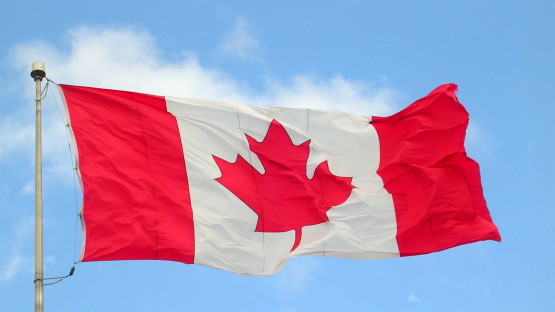Flag of Canada (Jared Grove/Wikipedia)
An International Atomic Energy Agency (IAEA) team of experts said Canada is committed to strengthening its regulatory framework for nuclear and radiation safety. The team also noted areas for further enhancement.
The Integrated Regulatory Review Service (IRRS) team today concluded an 11-day mission to review the regulatory safety framework in Canada. The mission was conducted at the request of the Government of Canada and hosted by the Canadian Nuclear Safety Commission (CNSC). The team also met with representatives of Natural Resources Canada and Health Canada.
Using IAEA safety standards and international best practices, IRRS missions are designed to strengthen the effectiveness of the national regulatory infrastructure, while recognizing the responsibility of each State to ensure nuclear and radiation safety.
"Canada has a comprehensive framework for nuclear and radiation safety covering current facilities and activities," said team leader Marta Ziakova, Chairperson of the Nuclear Regulatory Authority of Slovakia. "Moreover, CNSC strives to continuously upgrade its regulatory framework to address new challenges in relation to upcoming technologies, such as small modular reactors."
Nuclear power generates about 15 per cent of Canada's electricity. The country has 19 operating nuclear power reactors at four sites and develops and exports reactor technology. Canada also operates uranium mines and mills, processing and fuel fabrication facilities, and waste storage sites. Canada uses radiation sources in medical and industrial applications and in science and research. It operates five research reactors.
"While we are always looking for opportunities for improvement and welcome recommendations from our international colleagues, the IRRS review confirms that the CNSC has a strong regulatory framework and continues to ensure the safe operation of nuclear facilities in Canada," said Ramzi Jammal, CNSC Executive Vice-President and Chief Regulatory Operations Officer.
The 24-member team comprised 20 senior regulatory experts from 17 countries, as well as four IAEA staff members.
"This mission recognizes Canada's ongoing commitment to continuous improvement and the implementation of the IAEA safety standards, which serve as the recognized international basis for nuclear and radiation safety," said David Senior, Head of the IAEA's Regulatory Activities Section. "The findings will help to enhance regulatory effectiveness in nuclear power plant ageing management and the safe handling of radioactive waste."
The team observed regulatory inspection activities at power and research reactors, radioactive waste management facilities, a site with decommissioning activities, research centres, a conversion facility, a hospital, a radioactive sources production facility with transportation activities, an industrial radiography facility and an industrial irradiator.
The team identified several good practices, including:
- The CNSC is highly transparent about its regulatory activities and decisions.
- Health Canada has raised public awareness of naturally occuring radon.
The team provided several recommendations and suggestions aimed at enhancing Canada's regulatory framework, including:
- The Government should enhance the policy and strategy for radioactive waste management.
- The CNSC should consider better aligning its radiation protection requirements with IAEA safety standards.
The final mission report will be provided to the Government in about three months. The Government plans to make the report public.







